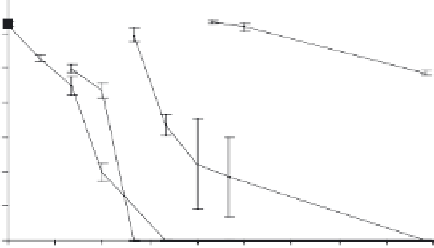Agriculture Reference
In-Depth Information
disease reduction occurred with application of phages the same day as inoculation in both
pathosystems.
Maximizing the chances for an interaction between phage and target bacterium is of
critical importance. The success of any biocontrol treatment is infl uenced by agent and
target densities (Johnson, 1994). In the case of phage therapy, there is a need for high
populations of both phage and bacterium, in order to start the 'chain reaction' of bacte-
rial lysis (Gill & Abedon, 2003). Therefore, a threshold concentration should exist above
which phages provide good control regardless of the applied concentration but below that
threshold phages will not exert a pronounced effect on the bacterial population. Several
fi ndings support this threshold effect hypothesis. Balogh (2002) found that a phage
mixture provided similar levels of control of tomato bacterial spot if applied at 10
6
or
10
8
PFU ml
−1
concentration, but was ineffective at 10
4
PFU ml
−1
.
Phages encounter a number of adverse factors in the phyllosphere, which substantially
reduce their persistence, rapidly diminishing their populations under the threshold level,
thus reducing their residual activity. These include sunlight irradiation, especially in the
UV A and B regions, desiccation and exposure to certain chemical pesticides, such as
copper compounds (Iriarte
et al.,
2007). Additionally, phage persistence varies depending
on the ambient temperature (Iriarte
et al.,
2007). Under fi eld conditions sunlight irradia-
tion is the single major factor hindering phage persistence (Iriarte
et al.,
2007). In stud-
ies by Iriarte
et al
. (2007), phage population numbers declined sharply during the early
afternoon hours but persisted at much higher levels when applied in the early evening, and
were highly correlated with the intensity of sunlight UV irradiation (Figure 13.1).
Several strategies have been evaluated for increasing phage persistence, including
the use of protective formulations, application scheduling for sunlight avoidance and
co-application of bacterial hosts for
in vivo
phage propagation.
Development of solar protectants for increasing biocontrol effi cacy has been the focus
of considerable research not only in the case of bacteriophages, but also for entomopatho-
genic viruses and proteinacous biopesticides (Behle
et al.,
1996; Ignoffo
et al.,
1997;
Balogh
et al.,
2003; Arthurs
et al.,
2006). Balogh (2002) identifi ed compounds that, when
7
12
6
10
5
8
4
6
3
4
2
2
1
0
0
6:00 9:00 12:00 15:00 18:00 21:00 0:00
3:00
6:00
9:00
Time of day
Figure 13.1
Changes in bacteriophage populations applied to fi eld tomatoes at different times of day.
Phage was applied at 6:00 (solid squares), at 10:00 (open diamonds), at 14:00 (solid triangles) or at 19:00
(open circles). Dotted line indicates sunlight UV irradiation.





















































































